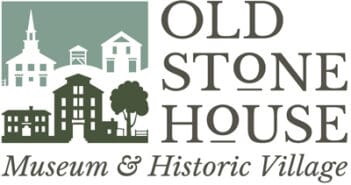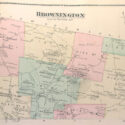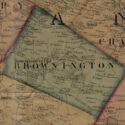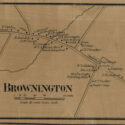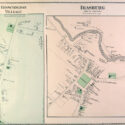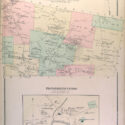Town Facts:
- Granted to Daniel and Timothy Brown in 1790
- The first grog shop in Orleans county is said to have been kept in Brownington, near where Wm. Baxter built his large house – upon the same farm upon which Major Smith set out the great orchard.
Brownington Historic District
The village of Brownington, Vermont, in the rural countryside of the Northeast Kingdom, was once bustling area in the early 18th century. The stage coach stopped here on its journey between Lower Canada and Boston, Massachusetts. The first road in the county, the Hinman Settler Road, went through Brownington, connecting the town of Greensboro VT with Derby
Until the railroads chugged north in the mid-1800s, the village remained an important center of industry. The growth of water power also caused residents to move from hill towns to valleys, where the water could be found.
Today the northern part of the village is the Brownington Historic District and has been listed on the National Registry of Historic Places since 1973. The Orleans County Historical Society (OCHS) owns six buildings, one observatory, and 55 acres of land in and near this district. The six buildings are: the Samuel Read Hall House, the Cyrus Eaton House, the Twilight Homestead, the Twilight Farmhouse, the Old Stone House and the Lawrence barn. The three buildings not owned by the Historical Society, but also a part of the Historic District, are the Orleans Country Grammar School building, the former Rice and Going Hotel, and the Brownington Congregational Church.
The Samuel Read Hall House was built in 1831 by a young lawyer named George Carlton West. West moved to Brownington in 1822 from Norwich, Vermont where he had practiced law. The house he designed was Federal-style, modeled after houses from his former home of Norwich. Although West was in the process of building a house for himself in Brownington, he moved away before it was finished. Samuel Read Hall moved into the house in 1856 when he took on the position of pastor of the Brownington Congregational Church and the headmaster of the Orleans County Grammar School.
Cyrus Eaton built his house in 1834. As an early emigrant from Canada, he owned much of the land in the now Historic District, so it was Eaton who sold land to Alexander Twilight for his home and school dormitory. He became a friend of Twilight’s and helped in the construction of the dormitory. The Eaton House was once the OCHS administrative office building, but now houses the archives and research library.
The Twilight Homestead is a small wood framed building of only three rooms that first served as Alexander Twilight’s first home when he arrived in Brownington in 1829. He and his wife lived there for less than a year when he started building another larger house. This building today is used by the OCHS as an educational building.
Twilight’s second home was two-stories, with the second story being used as dormitory rooms for students who were attending the Orleans County Grammar School. This was the first step towards the granite dormitory which now sits across the road. The building belonged to the Perry family before the OCHS purchased it. The house is now the visitor center for the Museum and the OCHS headquarters.
The Old Stone House, which is a four-story granite building, is the focal point of the Historic District. The building was finished in 1836, constructed as a dormitory for the Orleans County Grammar School. It was known as Athenian Hall then. Alexander Twilight, a man of mixed African-American ancestry, not only built it but presided over it during his years as principal of the school.
The Lawrence Barn was not originally built in Brownington; it was donated by Ruth and Roland Lawrence family of Albany, VT in 1997. The barn is currently being used as an exhibit of farming and farm equipment in Orleans County.
The observatory was built on the top of Prospect Hill in 1898 just up the road from the OCHS headquarters in Brownington. William Barstow Strong, an alumnus of the school, paid for its creation, and it was rebuilt two more times since then.
Also up the road from the OCHS headquarters is the Brownington Congregational Church, which was built in 1841. For years before that, the congregation had been meeting on the second floor of the Grammar School building. William Barstow Strong, who built the Observatory on Prospect Hill, paid for a new church bell and pews in 1899.
Athenian Hall, or the Old Stone House
The Old Stone House started as the grand vision of Alexander Twilight. The Rev. Mr. Twilight first saw Brownington in 1829, when he arrived to become minister of the Congregational Church and the Preceptor (Principal) of the Orleans County Grammar School. The co-educational “Brownington Academy,” as it was often called, had been founded only six years earlier, and was the only secondary, or high school, in the county.
Twilight felt strongly that if the Academy was to compete successfully with other institutions it would have to provide a well-equipped dormitory for its students. Unable to convince the school’s trustees of the need for such a building, he concluded that he would have to erect it as a private venture. One of the many unsolved mysteries about the Old Stone House is how one man, on the salary of a minister and schoolmaster, was able to finance the construction of this enormous building. He started to work on it in 1834.
There are hosts of fascinating legends about how he built the “Stone Boarding House.” Although there is evidence to the contrary, many believed Twilight himself quarried the granite blocks from neighboring fields and erected the building alone, using a wooden or earthen staging that rose as the building rose, together with a single ox that worked on a treadmill on the staging to raise the blocks into place. Local folklore has it that when the last stone was hauled to the top, it was found that the ox could not be lowered to the ground far below. Consequently the poor animal had to be slaughtered on the staging and was consumed in a great ox roast.
Twilight and his associates shared the popular veneration for Ancient Greece; they named the new building “Athenian Hall.” More commonly, it was known as the Stone Boarding House. Serving both boys and girls, the building was outfitted in a rather Spartan manner, without indoor plumbing or central heating. The huge kitchen fireplace and fifteen tiny charcoal fireplaces apparently supplied most of the heat. Wash water was collected from the roof in a huge underground cistern, from which it was fed by gravity into the kitchen.
The County Grammar School trustees had purchased Athenian Hall from its builder during the 1840s, but ownership reverted back to the Twilights. Mercy Twilight, Alexander’s wife, ran a boarding house for some years after Alexander died, but couldn’t keep enough business to thrive. She sold it off to the Addison family, friends of the Twilights who had followed them from Canada. That family held the title until 1916 when the Orleans County Historical Society became interested in saving the structure for eventual use as a museum. The other interested party had wanted to purchase the building to tear it down to use the blocks as granite railroad bridge abutments. The Historical Society purchased the building for five hundred dollars.
During the years before it was rescued by the Historical Society, much of the building had remained empty and little had changed. Only the first floor, divided into two apartments, had been lived in. The upper three floors had been kept intact. Having suffered only superficial deterioration and weathering, the edifice was a unique example of the early nineteenth-century institutional building. Only the interior fixtures and furnishings were missing; they had been sold off after the closing of the building.
The Old Stone House, which is a four-story granite building, is the focal point of the Historic District.
